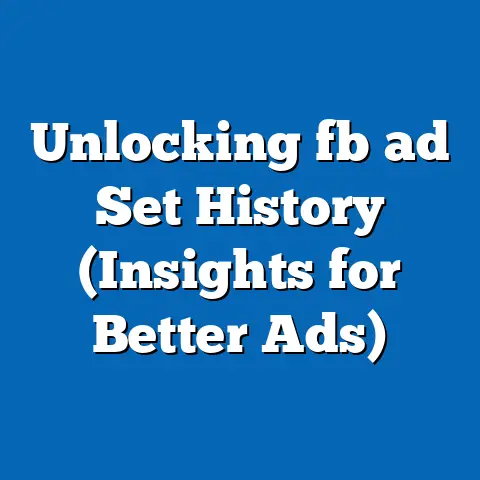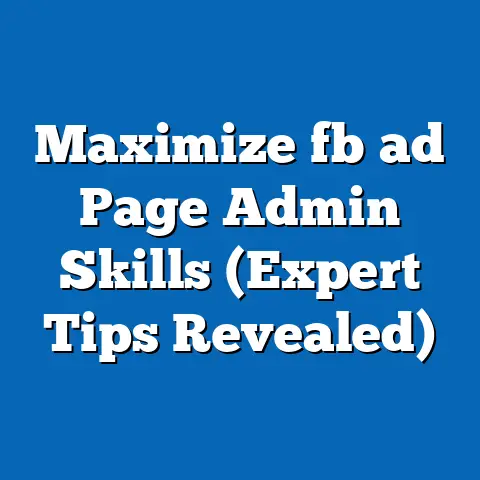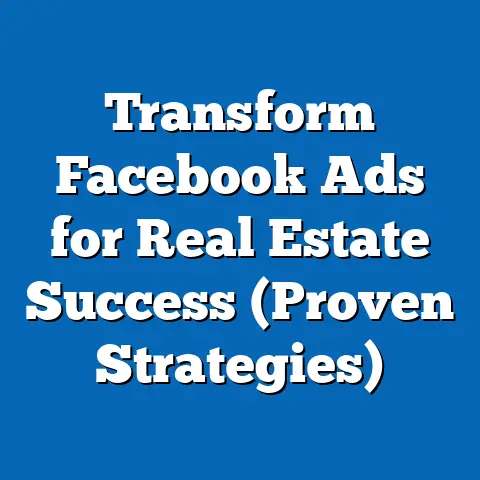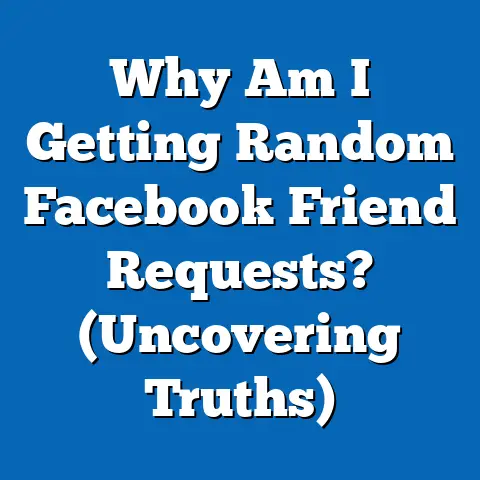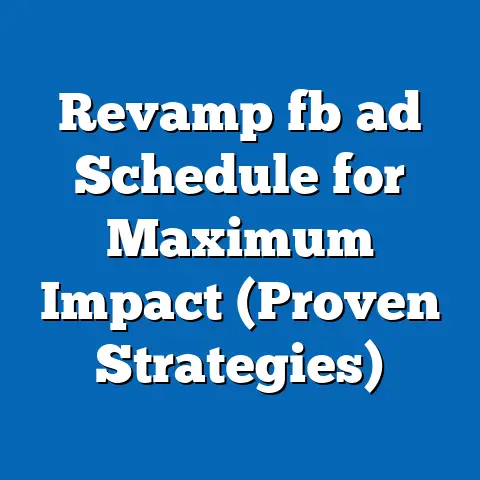How Much to Advertise on Facebook? (Cost Breakdown Revealed)
Imagine Facebook advertising as planting a garden. Just as a gardener must consider the type of soil, seeds, and climate to cultivate a thriving garden, a business must navigate various elements of Facebook advertising—budget, audience, and ad format—to reap a bountiful harvest of leads and sales. I’ve seen many businesses, both big and small, either flourish or wither based on how strategically they approach this “digital gardening.” It’s not just about throwing money at the problem; it’s about understanding the ecosystem and nurturing your campaign for optimal growth.
In this guide, I’ll break down the often-murky world of Facebook advertising costs, providing you with a clear roadmap to building a budget that works for your business. We’ll explore everything from the different types of costs you’ll encounter to the factors that influence them and, most importantly, how to analyze your return on investment (ROI). Get ready to dig in and cultivate some serious success!
Understanding Facebook Advertising Costs
Facebook advertising has become a cornerstone of modern digital marketing. With billions of active users, the platform offers unparalleled reach and targeting capabilities. But with great power comes great… cost concerns! Understanding the underlying cost structure is crucial for any business looking to leverage Facebook’s advertising prowess.
At its core, Facebook advertising operates on an auction system. Advertisers bid against each other to show their ads to specific target audiences. The winning bid, combined with other factors like ad quality and relevance, determines who gets their ad shown and at what price. This dynamic environment means costs can fluctuate significantly, making it essential to grasp the factors at play.
Facebook doesn’t just pick the highest bidder. I’ve seen campaigns with lower bids outperform those with significantly higher bids simply because their ads were more engaging and relevant to the target audience. This is where Facebook’s algorithm comes into play, rewarding ads that provide value to users.
Types of Costs Involved
When diving into Facebook advertising, you’ll encounter several key cost metrics. Understanding these is vital for optimizing your campaigns and making informed decisions.
Cost Per Click (CPC)
Definition: CPC is the amount you pay each time someone clicks on your ad.
Why it’s important: CPC is a crucial metric for direct response campaigns where your primary goal is to drive traffic to your website or landing page. A lower CPC means you’re getting more clicks for your budget.
How to interpret it: If your CPC is high, it could indicate that your ad copy isn’t compelling enough, your targeting is too broad, or your ad quality is low.
My experience: I once worked on a campaign where the initial CPC was sky-high. By refining the ad copy, adding a more compelling call-to-action, and narrowing down the target audience, we were able to reduce the CPC by over 50% and significantly increase the campaign’s overall effectiveness.
Cost Per Mille (CPM)
Definition: CPM, also known as Cost Per Thousand, is the amount you pay for every 1,000 impressions your ad receives. An impression is counted each time your ad is displayed to a user, regardless of whether they click on it.
Why it’s important: CPM is particularly useful for brand awareness campaigns where your goal is to increase visibility and reach a large audience.
How to interpret it: A high CPM might indicate that your target audience is highly competitive or that your ad placement is expensive.
CPM vs. CPC: While CPC focuses on direct response, CPM is about visibility. I’ve found that a combination of both can be powerful. A brand awareness campaign with a low CPM can warm up your audience, making them more likely to click on your direct response ads with a lower CPC later on.
Cost Per Action (CPA)
Definition: CPA is the amount you pay for a specific action taken by a user, such as a lead submission, a purchase, or an app install.
Why it’s important: CPA is directly tied to your campaign goals and provides the clearest indication of your advertising effectiveness.
How to interpret it: A low CPA means you’re efficiently achieving your desired outcome, while a high CPA might indicate that your landing page isn’t optimized for conversions or that your targeting is off.
CPA and the Customer Journey: CPA is often the ultimate metric I focus on. I’ve seen businesses get so caught up in CPC or CPM that they lose sight of the actual goal. Remember, driving traffic is only valuable if it leads to conversions.
Factors Influencing Facebook Ad Costs
Understanding the different types of costs is only half the battle. You also need to understand the factors that influence these costs. Here are some of the most significant:
Target Audience
How it affects costs: The more specific and competitive your target audience, the higher the cost. For example, targeting a niche group of high-income professionals will likely be more expensive than targeting a broad demographic.
My insight: I always advise clients to start with a well-defined audience but to also test different variations. Sometimes, a slightly broader audience can yield better results at a lower cost.
Demographics and Interests: Facebook’s detailed targeting options allow you to reach users based on demographics (age, gender, location), interests (hobbies, passions), and behaviors (purchase history, online activity). The more specific your targeting, the higher the cost.
Ad Placement
How it affects costs: Where your ad appears on Facebook (e.g., news feed, stories, right column) can significantly impact costs. Some placements are more competitive and therefore more expensive.
Placement Strategies: I’ve found that testing different placements is crucial. What works for one business might not work for another. For example, visual ads often perform well in Instagram Stories, while more text-heavy ads might be better suited for the Facebook news feed.
Mobile vs. Desktop: Mobile placements are generally more affordable due to higher inventory. However, conversion rates on mobile might be lower, so it’s important to track performance carefully.
Ad Quality and Relevance Score
How it affects costs: Facebook’s algorithm rewards high-quality ads that are relevant to the target audience. Ads with high-relevance scores are shown more often and at a lower cost.
Relevance Score Explained: Facebook assigns a relevance score to your ads based on user feedback. Positive feedback (clicks, shares, likes) increases the score, while negative feedback (hiding the ad, reporting it) decreases the score.
Improving Ad Quality: To improve your ad quality, focus on creating engaging and informative content that resonates with your target audience. Use high-quality images and videos, write compelling ad copy, and test different variations to see what works best.
Time of Year & Competition
How it affects costs: During peak seasons like holidays or major shopping events, competition for ad space increases, driving up costs.
Seasonal Strategies: Plan your campaigns in advance to avoid bidding wars during peak seasons. Consider running ads earlier in the season to capture attention before the competition intensifies.
Competitive Analysis: Keep an eye on what your competitors are doing. If they’re running aggressive campaigns, you might need to increase your bids to stay competitive.
Budgeting for Facebook Ads
Now that you understand the costs involved and the factors that influence them, let’s talk about budgeting.
Setting an Effective Budget: There’s no one-size-fits-all answer to how much you should spend on Facebook ads. The ideal budget depends on your business goals, target audience, and industry.
Daily vs. Lifetime Budgets:
- Daily Budget: Sets an average amount you’re willing to spend each day. Facebook will try to spend this amount, but it might fluctuate slightly.
- Lifetime Budget: Sets a total amount you’re willing to spend over the entire duration of your campaign. Facebook will optimize your spending to ensure you don’t exceed this amount.
I typically recommend daily budgets for ongoing campaigns and lifetime budgets for campaigns with a specific end date.
Monitoring and Adjusting Budgets:
- Track Key Metrics: Regularly monitor your CPC, CPM, CPA, and ROI.
- Adjust Bids: If your costs are too high, try lowering your bids. If your costs are low but you’re not getting enough results, try increasing your bids.
- Pause Underperforming Ads: Don’t be afraid to cut your losses. If an ad isn’t performing well, pause it and focus on optimizing your better-performing ads.
Analyzing Return on Investment (ROI)
Ultimately, the success of your Facebook advertising efforts comes down to ROI. Are you getting more out of your campaigns than you’re putting in?
Calculating ROI:
- Track Conversions: Use Facebook Pixel to track conversions on your website, such as purchases, leads, or sign-ups.
- Calculate Revenue: Determine the revenue generated by your Facebook ads.
- Divide Revenue by Ad Spend: ROI = (Revenue – Ad Spend) / Ad Spend
Industry Benchmarks: ROI can vary significantly by industry. Some industries, like e-commerce, might see higher ROI than others, like professional services.
Long-Term Benefits: Don’t just focus on immediate sales. Facebook advertising can also build brand awareness, generate leads, and nurture customer relationships, all of which can contribute to long-term growth.
Real-World Examples & Case Studies
Let’s look at a few real-world examples to illustrate how businesses can successfully navigate Facebook advertising costs.
Case Study 1: E-commerce Startup
- Business: An online retailer selling handcrafted jewelry.
- Strategy: Started with a small daily budget and targeted a niche audience of fashion-conscious women. Focused on high-quality product photos and compelling ad copy.
- Results: Achieved a positive ROI within the first month and gradually increased their budget as their sales grew.
Case Study 2: B2B Software Company
- Business: A software company selling project management tools.
- Strategy: Used a lifetime budget for a lead generation campaign. Targeted professionals in specific industries with ads highlighting the benefits of their software.
- Results: Generated a steady stream of qualified leads at a reasonable CPA and converted many of those leads into paying customers.
Case Study 3: Local Restaurant
- Business: A local restaurant looking to attract more customers.
- Strategy: Ran ads targeting people within a 5-mile radius of their restaurant. Showcased mouthwatering photos of their dishes and offered special promotions.
- Results: Saw a significant increase in foot traffic and revenue during the campaign period.
Key Takeaways:
- Start small and test different strategies.
- Focus on targeting the right audience.
- Create high-quality, engaging content.
- Track your results and adjust your budget accordingly.
Conclusion
Understanding the costs associated with Facebook advertising is crucial for success. By grasping the different types of costs, the factors that influence them, and how to analyze your ROI, you can make informed decisions about your advertising investments.
Remember, Facebook advertising is not a one-time event but an ongoing process of experimentation and optimization. Don’t be afraid to try new things, track your results, and adjust your strategy as needed.
With a solid understanding of the costs involved and a strategic approach to budgeting, you can unlock the full potential of Facebook advertising and achieve your business goals. Now go forth and cultivate your own thriving Facebook ad “garden”!


